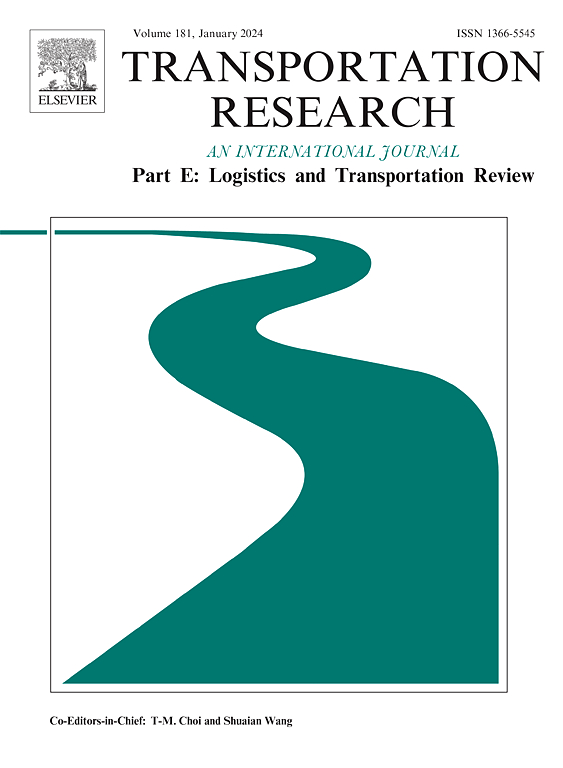优化具有时间窗口的自主多式联运最后一英里交付系统:分析无人机、机器人和卡车之间的权衡
IF 8.8
1区 工程技术
Q1 ECONOMICS
Transportation Research Part E-Logistics and Transportation Review
Pub Date : 2025-10-04
DOI:10.1016/j.tre.2025.104427
引用次数: 0
摘要
本文研究了多式联运最后一英里配送系统。更具体地说,它引入了带有机器人站和时间窗口的无人机辅助车辆路线问题(VRPD-RS-TW),以面对最后一英里物流中的紧急交付时间表。VRPD-RS-TW适用于人口密集的城市中心,由于基础设施问题,传统卡车可能难以到达客户。这个问题的特点是利用三种运输方式:卡车、无人机和机器人合作递送包裹,并满足时间窗口要求。为了解决这个问题,我们提出了一个混合整数线性规划(MILP)公式,有效的不等式来加强线性松弛,并提出了一个三相颗粒多启动迭代局部搜索(3P-GMS-ILS)元启发式算法。对阿姆斯特丹(荷兰)实例的计算研究表明,在目标函数值和计算时间方面,3P-GMS-ILS优于MILP公式和最先进的元启发式方法。此外,我们还深入分析了VRPD-RS-TW的有效性,表明在各种成本情景下,卡车、无人机和机器人的组合优于运输方式较少的情景。在研究的成本场景中,VRPD-RS-TW同时协调了更高的交付业务量,其中48.75%由无人机和机器人执行,从而产生比相关运输系统更好的目标函数值。在卡车路线成本低于无人机和机器人的场景下,VRPD-RS-TW仍然比相关运输系统实现了更好的目标函数值,尽管无人机和机器人的配送份额下降到14.78%。这表明,当卡车搭载无人机时,增加无人机并不一定有益,因为卡车需要等待无人机,这可能会导致无人机路线和司机工资相关的成本增加。本文章由计算机程序翻译,如有差异,请以英文原文为准。
Optimizing autonomous multimodal last-mile delivery systems with time windows: Analyzing trade-offs between drones, robots, and trucks
This paper studies multi-modal last-mile delivery systems. More specifically, it introduces the Drone-Assisted Vehicle Routing Problem with Robot Stations and Time Windows (VRPD-RS-TW) to face exigent delivery schedules in last-mile logistics. The VRPD-RS-TW applies to highly populated city centers, where due to infrastructural issues, customers might be hard to reach by conventional trucks. This problem is characterized by utilizing three transportation modes: trucks, drones, and robots collaborating to deliver parcels and meet time window requirements. To solve this problem, we develop a Mixed Integer Linear Programming (MILP) formulation, valid inequalities to strengthen the linear relaxation, and a Three-Phased Granular Multi-Start Iterated Local Search (3P-GMS-ILS) metaheuristic algorithm. A computational study on instances of Amsterdam (the Netherlands) demonstrates that the 3P-GMS-ILS outperforms the MILP formulation and state-of-the-art metaheuristic approaches in terms of both objective function values and computational times. Furthermore, we provide insights into the effectiveness of the VRPD-RS-TW, showing that, under various cost scenarios, the combination of trucks, drones, and robots outperforms scenarios with fewer transportation modes. Across the studied cost scenarios, the VRPD-RS-TW simultaneously coordinates a higher volume of delivery operations, with 48.75 % performed by drones and robots, resulting in better objective function values than the related transportation systems. In scenarios where truck routing costs are lower than those of drones and robots, the VRPD-RS-TW still achieves better objective function values compared to the related transportation systems, although the share of drone and robot deliveries drops to 14.78 %. This shows that adding drones is not necessarily beneficial when trucks carry drones, as trucks should wait for drones, which might result in higher costs related to drone routing and drivers’ wages.
求助全文
通过发布文献求助,成功后即可免费获取论文全文。
去求助
来源期刊
CiteScore
16.20
自引率
16.00%
发文量
285
审稿时长
62 days
期刊介绍:
Transportation Research Part E: Logistics and Transportation Review is a reputable journal that publishes high-quality articles covering a wide range of topics in the field of logistics and transportation research. The journal welcomes submissions on various subjects, including transport economics, transport infrastructure and investment appraisal, evaluation of public policies related to transportation, empirical and analytical studies of logistics management practices and performance, logistics and operations models, and logistics and supply chain management.
Part E aims to provide informative and well-researched articles that contribute to the understanding and advancement of the field. The content of the journal is complementary to other prestigious journals in transportation research, such as Transportation Research Part A: Policy and Practice, Part B: Methodological, Part C: Emerging Technologies, Part D: Transport and Environment, and Part F: Traffic Psychology and Behaviour. Together, these journals form a comprehensive and cohesive reference for current research in transportation science.

 求助内容:
求助内容: 应助结果提醒方式:
应助结果提醒方式:


